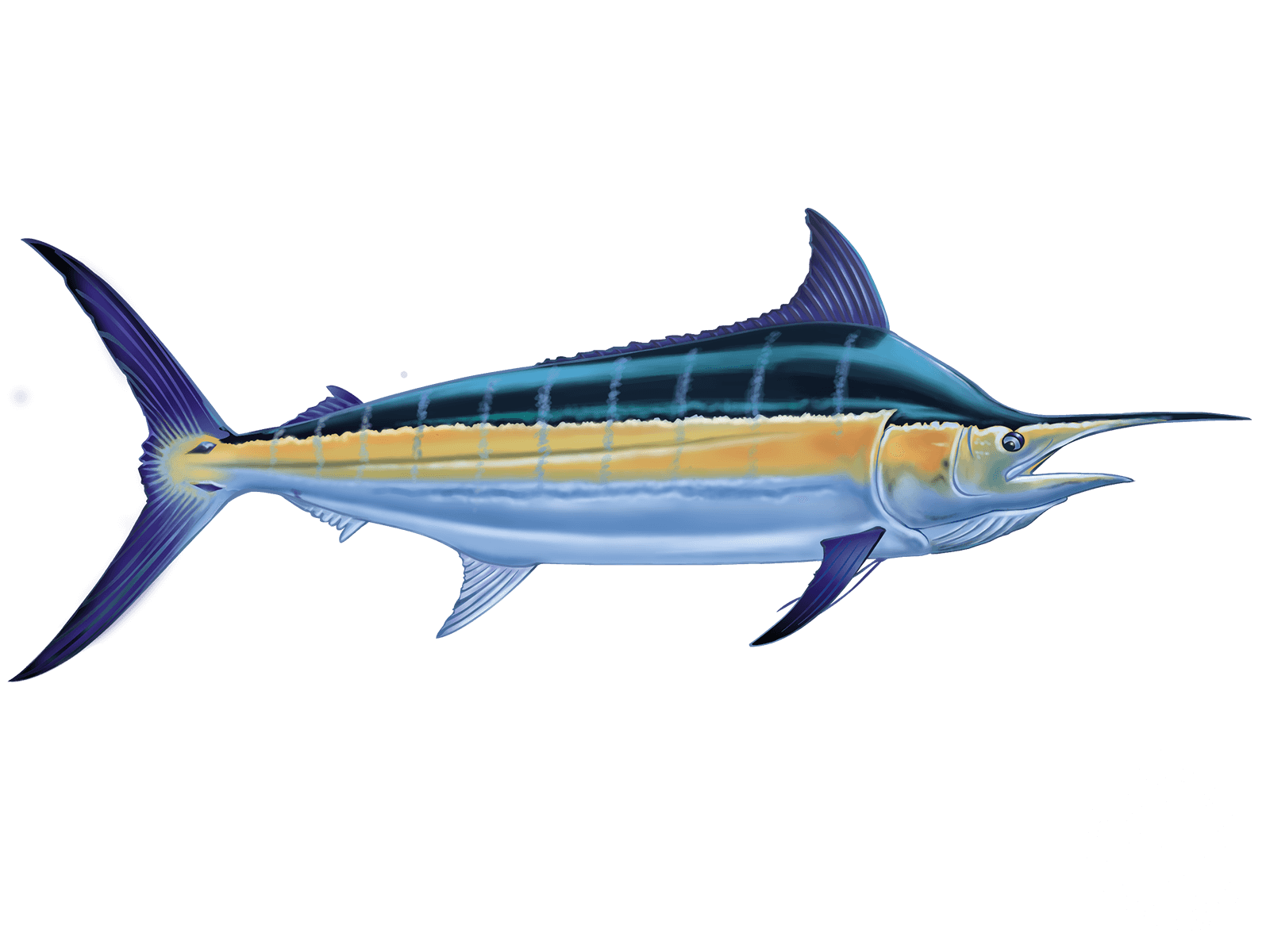Black Marlin

Species Details
Istiompax Indica
Istiophoridae
Perciformes
Offshore, Warm Water
300 - 1560 lbs.
120" - 183"
Black Marlin (Istiompax indica) Fish Description
The Black Marlin (Istiompax indica) is a member of the Istiophoridae fish species. Much like its closest relative, the Blue Marlin, the black variant has that long, sword-like bill and a streamlined body. They both have a fan-like dorsal fin that extends from the top of the head to the tail base. They both also have a two-tone body coloration—dark on the top and silvery white on the lower part.
The difference between the two marlins begins at their size with the Black Marlin having more girth and length than the blue ones. The Black also has a darker blue to black color (hence the name) above the lateral line as compared to the Blue’s lighter blue tones. The Black doesn’t have those distinct white stripes along the body that the Blue ones usually have. Moreover, the Blacks are sometimes called short-nosed swordfish because their bills are a bit shorter compared to the Blues’.
As for their swimming speeds, the Black Marlin is “a little bit slower” than the Blues. Not only because it is much bulkier and less streamlined than Blues, but because its pectoral fins are fixed and rigid and unable to fold against its body, thus, contributing to the drag. Just a reminder, though, that we’re emphasizing the “little bit slower than the Blues” part because it’s still known as one of the fastest swimmers in the ocean, clocking up to eighty miles per hour at full speed.
But what the Black “lacks” in speed, it certainly makes up in power. Black Marlins are known to be one of the hardest gamefish to land because of their brute strength and aggressive behavior. In fact, fishing for Blacks is often quite dangerous as they’re known to be tough fighters when hooked—attacking both boat and anglers by trying to impale them with their long bill.
Interesting Facts About Black Marlins
- The biggest Black Marlin ever caught measured fourteen feet in length and weighed a whopping one thousand five hundred and sixty pounds.
- The world record fish was caught by angler Alfred Glassell Jr. at Cabo Blanco, Peru in 1953.
- They’re one of the largest in the Istiophoridae family.
- Females are mostly a little bit bigger than males.
- Because of some similarities, Black marlins are often confused with their cousins, the Blue Marlins.
- They are migratory and can travel hundreds or even thousands of miles across the ocean.
- They can reach amazing speeds of up to eighty miles per hour.
- They are carnivorous and mostly prey on squids, scads, mackerel, cuttlefishes, octopuses, and other small fish.
- They have been known to attack boats and other floating things in the ocean with their long bills.
- Their speed and strength make them one of the toughest gamefish to catch.
- They are one of the most sought after gamefish for sport fishers looking for a challenge.
Black Marlins Average Size and Swimming Speed
Although they can reach lengths of up to fourteen feet, average sizes tend to be within eleven feet, weighing around two hundred to four hundred pounds. They are also known to be one of the fastest swimmers in the ocean, with top speeds (often in short bursts) of up to eighty miles per hour. Average speeds, however, were clocked between twenty and fifty miles per hour.
Where to Find Them - Habitat and Distribution
The Black Marlin is typically found in tropical and subtropical waters of the Indian and Pacific Oceans. It usually swims in the open sea near the surface. However, unlike their Blue cousins that usually stay in the open seas, the Blacks sometimes wander closer to the shore, especially when the waters are warm within reefs and near the islands.
Although there are some sightings of Black Marlins in US waters, particularly near the southernmost part of the west coast, they are quite rare. If you’re targeting this highly-prized gamefish on your next fishing adventure, you may want to try your luck in countries where they are most abundant, namely: in The Great Barrier Reef in Australia, in the waters of Central America from Panama, Costa Rica, to Peru, in the waters between Mozambique and Madagascar in Africa, as well as in the Indian Ocean near the shores of Sri Lanka and India.
Black Marlin Fishing Tips
Black Marlins are known to be speedsters and brutes and they tend to stay in the open seas. So you’re going to need a boat and a piece of sturdy equipment. If you’re planning on chartering, make sure that, aside from the boat equipped with the appropriate tackle, the captain or your guide will be familiar with the local Black Marlin fishing spots. If you’re going to be bringing your own gear, we highly suggest a heavy trolling outfit tough enough to handle these oceanic brutes. Live baits—particularly small tunas, bonito, and other forage fish bridled to a large hook—are often effective enticements to get the fish to bite. You may also need to employ a bit of slow trolling around drop-offs and reef edges. Also, stay away from the Marlin’s long bill while you’re trying to land the fish as it can cause serious damage. Lastly, make sure that you’re 100% fit before you attempt to catch this monster of a fish as you’re going to be in for a long and exhausting battle once you hook one.







